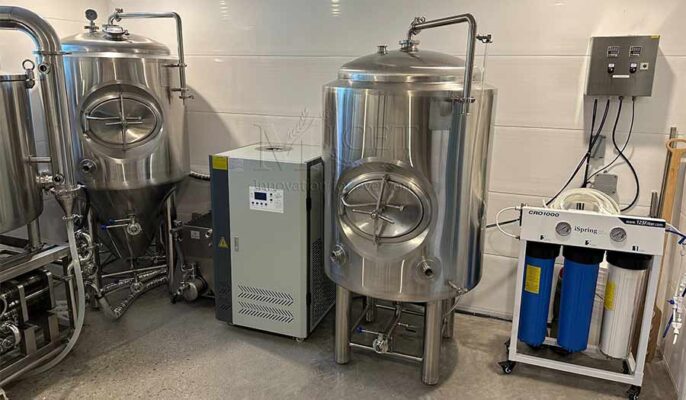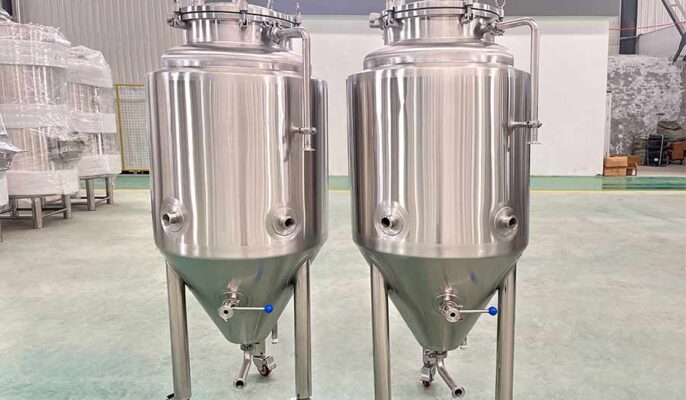Nanobreweries are small breweries that produce limited quantities of craft beer. These breweries often focus on unique craft beers and often serve the local market. The difference between large breweries, craft breweries, and small breweries is the amount of beer produced. The difference between a nano brewery and a microbrewery is the size of the brewery. The simple definition of a nano brewery is any brewery that produces batches of three barrels or less.
Was ist eine Nanobrauerei?
The simple definition of a nanobrewery is that it is a brewery or brewpub that produces less than 15,000 barrels of beer per year. The annual cap at the Nano level is defined than at other levels.
A New Hampshire law limits nanobrewery production to 2,000 barrels per year, but not every state has such a law.
Some say a nanobrewery is a brewery that brews three barrels or less of beer per batch. This definition seems to be the most common, so we can continue to use that definition for now.
Wie gründet man eine Nanobrauerei?
Determine your goals and vision
Before entering the world of nanobrewing, you must have a clear understanding of your goals. What type of beer do you want to brew? Are you targeting a specific audience or group of people? Your goals and vision will become the foundation of your nanobrewery and help guide your decisions throughout the process.
Durchführung von Marktforschung
Market research is critical to understanding competition and identifying opportunities in the craft beer industry. Research local and regional trends, analyze competitors’ strengths and weaknesses, and assess demand for specific beer styles or flavors.
Choose brewery size
Nanobreweries vary in size and production capacity. Decide how much beer you want to produce and how you want to distribute it. Consider starting small and scaling up as demand for your beer increases.
Einen Geschäftsplan entwickeln
A solid business plan is critical to obtaining funding and guiding the development of a nanobrewery. Include details about your target market, financial projections, equipment and raw material costs, and marketing strategy.
Understand legal requirements
You must get the necessary permits and licenses to operate a nanobrewery. you’ll need a federal brewer’s notification from the Alcohol and Tobacco Tax and Trade Bureau (TTB), state and local alcohol licenses, and a business license. Additionally, it’s critical to familiarize yourself with local zoning, health and safety regulations that apply to your nanobrewery. As a responsible business owner, you will need to make the necessary modifications to your facility or brewing process to follow these regulations.

Nano brewery brewing equipment
- Braukessel: Zum Kochen der Würze, der Flüssigkeit, die beim Maischen gewonnen wird.
- Maischebottich: Ein Gefäß, in dem gequetschte Körner mit heißem Wasser vermischt werden, um vergärbaren Zucker zu extrahieren.
- Gärbehälter: Ein Behälter, in dem Würze und Hefe für die Gärung gemischt werden und Zucker in Alkohol umgewandelt wird.
- Wärmequelle: Brenner oder elektrisches Heizelement, das zum Beheizen des Brühkessels verwendet wird.
- Kühlsystem: Würzekühler, der die Würze nach dem Kochen abkühlt, bevor sie in den Gärbehälter umgefüllt wird.
- Desinfektions- und Reinigungsgeräte: notwendig zur Aufrechterhaltung der Hygiene und zur Vermeidung von Kontaminationen.
- Measuring and testing tools: hydrometer, thermometer and pH meter for monitoring the brewing process.
- Flaschen- oder Fassabfüllanlagen: dienen der Verpackung von fertigem Bier.
Nanobrewery system equipment functions
Although smaller in capacity than its larger counterparts, the Nano Brewing System is a functional brewing device. The essence of brewing is the same regardless of scale, but nanobrewing often emphasizes precision and flexibility.
Maische
The grains are soaked in hot water to convert the starches into fermentable sugars. The nanobrewing system must maintain a consistent temperature during this stage, which is critical for flavor and alcohol content.
Kochend
After mashing, the wort is boiled, usually for an hour, during which time hops are added. Boiling serves many purposes: sterilizing the wort, extracting flavor from the hops, and evaporating unwanted volatile compounds.
Abkühlung
After boiling, it is crucial to cool the wort . Rapid cooling aids in the formation of cold cracks (solidified and settled proteins), which contributes to beer clarity and stability.
Gärung
The cooled wort is transferred to fermenters, where yeast is added. The yeast consumes the sugar in the wort, producing alcohol and carbon dioxide. The nanobrewing system will feature Gärbehälter that are easy to watch and sample.
Carbonation and packaging
After fermentation is complete, the beer is either carbonated using forced carbon dioxide or carbonated using priming sugars. Once carbonated, the beer is ready for packaging, either in bottles, cans or kegs.
Reinigen und desinfizieren
A vital but sometimes overlooked feature. Proper cleaning and sanitation ensures that unwanted microorganisms do not spoil your beer. Many modern nanobrewing systems come with integrated cleaning systems, making the process more efficient.
Nano brewing brewery cost
The cost of a nanobrewing system can vary depending on some factors, including its capacity, the quality of the equipment, the brand, and the extra features it offers. For those keen to set up a nanobrewery, understanding the cost implications is crucial.
Brewery equipment capacity and price range:
| CAPACITY (BARRELS) | BRAND NAME | PRICE RANGE ($) |
| 1 | BrewTech | 2,000 – 4,000 |
| 2-3 | BrewMasters | 5,000 – 8,000 |
| 4-5 | BeerCraft | 9,000 – 12,000 |
| 6-10 | NanoKing | 13,000 – 20,000 |
Nano brewing system types
- All-in-one systems: These are compact systems that combine the mashing, boiling and fermentation processes in one unit.
- Space saving, perfect for small breweries or experimental batches. The price range is roughly $1,000 – $3,500.
- Modular systems: These units are more scalable than one-piece units, allowing breweries to add or upgrade individual components, such as fermenters or boilers, as they grow. Scalable for breweries anticipating future production growth. Price range is $3,500 – $12,000.
- Automated systems: They use technology to automate various brewing processes, such as temperature control, stirring, and even ingredient addition. Brewing is consistent and requires less manual intervention. Price range is $5,000 – $15,000.
- Gravity feed system: relies on gravity to transfer wort from one vessel to another, usually set up in a tiered structure.Fewer pumps and components, fewer possible problems. Price range is $2,500 – $8,000.
- RIMS (Recirculating Brewing Brewing System) and HERMS (Heat Exchange Recirculating Brewing System): RIMS use electric heating elements to heat the wort as it is recirculated. HERMS uses a heat exchanger for precise temperature control during the mashing process. Price range is $4,000 – $10,000.
There are various types of nanobrewing systems on the market, each designed to meet different brewing needs and capacity requirements.

Is it profitable to open a nanobrewery?
I’m sure every brewer will have at least one off-the-cuff idea. The idea is to sell craft beer to the public. They both wanted to share the joy of brewing beer with like-minded friends. However, professional brewing is not immune to many of the problems that other companies face. Such as cash flow, profitability, and whether it can pay employees. In response to these obstacles, brewing technology and start-up capital issues must also be overcome.
Nano Brewery is your best choice for starting a brewery. It doesn’t require much capital, and you can develop your own brewing skills through brewing. You need to believe it will bring you income, even if it’s not much. However, a nanobrewery is your first step to becoming a professional brewer. Most of the big breweries also started out as Nano Brewery.
How to choose a nano beer system?
Determine your capacity needs
It’s crucial to have a clear idea of how much beer you plan to produce. Are you brewing for personal consumption, a small bar, or a larger audience? This will determine the size and capacity of your desired brewing system.
Platzbeschränkungen
Measure the space where you plan to build your brewery. Nanobrewing systems come in a variety of configurations, some more space-efficient than others. Your available space will influence your system choice.
Budgetüberlegungen
Having a clear budget will narrow down your options and make the decision-making process simpler.
| BUDGET RANGE | RECOMMENDED SYSTEM TYPE | APPROXIMATE CAPACITY |
| $1.000 - $5.000 | All-in-One Systems | 1 – 3 BBL (Barrels) |
| $5.000 – $10.000 | Modular or RIMS/HERMS | 3 – 5 BBL |
| $10,000+ | Automated Systems | 5 BBL and above |
Skalierbarkeit
Will you be increasing your brewing capabilities in the next few years? Some systems allow easy expansion, while others may be more restrictive. It’s wise to invest in a system that has at least some room for growth.
Der Ruf des Herstellers
Research various makes and models. Look for reviews, especially from users who have similar needs to yours. Reputation is important; a respected brand usually means reliability and quality. Micet is known for its innovation, offering a variety of brewing systems suitable for beginners and professionals alike. Their products range from simple kettles to complex automated systems.
Get your nanobrewery turnkey solution
If you are planning to open a nanobrewery, you can contact Micet . Our engineers will manufacture beer equipment according to your brewing process. You can also contact us if you are planning to expand your brewery. Micet has professional technology and customized services and looks forward to cooperating with you!




